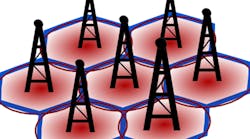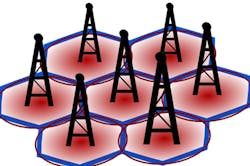Goals of 5G
The objectives of 5G are not very different from the goals of 4G—namely, higher data rates, greater user capacity, and lower latency. The goal is to keep up with the growing number of subscribers worldwide, along with the gradual addition of more machine-to-machine (M2M) and Internet-of-Things (IoT) nodes. One suggested target is an 1000× increase over the current capacity.
The desire for that increased data rate stems from increased mobile Internet access and video downloads. 4G LTE-Advanced provides a maximum rate of 1 Gb/s, while the proposed goal for 5G is 10 Gb/s with a minimum of 100 Mb/s. The target for latency is less than one millisecond.
Achieving these goals requires three key things: 1) many more cell sites in the infrastructure; 2) greater bandwidth, meaning more spectrum; and 3) improved link efficiency. There are known methods for achieving each, but in-depth research is being devoted to figuring out which are best to include in the standard.
The Need for Spectrum
To achieve the data rate goal requires more bandwidth per base station. Minimum typical bandwidth needs are about 200 MHz, while several GHz is required even with m-QAM to get to the 10 Gb/s level. The current mix of cellular spectrum, even if aggregated, just isn’t enough. Some have suggested that the use of cognitive radio techniques may work to share lower frequency spectrum (e.g., 2.3 GHz and 3.6 GHz). The obvious solution is much higher frequencies like the millimeter (mm) wave bands. Some proposed segments are 28, 38, 60, 70, and 90 GHz. No doubt a mix of technologies will be used, and they will be different with each carrier or country. More spectrum haggling is expected.
While these mm frequencies offer the bandwidth needed, they have a downside—namely, a more limited range. Physics dictates that as frequency increases, range correspondingly decreases. And line of sight (LOS) is a must in most cases. This will mean more base stations and the use of greater power and/or beam steering antennas.
Increased Capacity with Densification
Densification is the massive increase in the number of cell sites with wired backhaul. The 5G network will be a heterogeneous one with a massive number of micro, pico, and femto cells everywhere. Such a HetNet will not only increase capacity but also ensure higher data rates. To overcome indoor range limitations, one proposal suggests separate indoor and outdoor cell sites to mitigate the attenuation problem. Most cell phone calls are made from indoors (70-80%), and walls greatly block or attenuate mm wave signals.
Such densification will also require wireless backhaul densification. This probably will require aggregate backhaul links from strategically placed gateways.
MIMO Limits
One of the main components of 5G is multiple input multiple output (MIMO). MIMO is the use of multiple antennas with receive (RX) and transmit (TX) components. Spatial multiplexing minimizes multipath and fading while increasing data rates. The greater the number of MIMO channels, the greater the improvement of the link. MIMO is used now in LTE but sparingly, owing to space limitations in handsets and base stations. However, with mm wave frequencies, antennas are significantly smaller, meaning MIMO is somewhat easier to implement.
The proposal is to use massive MIMO with up to 64 or 128 antennas per base station and as many as practical in the phone. Multiple antennas can also be used to form agile beamforming directional phased arrays that can add power multiplication to offset range limitations. While all this is theoretical, it appears to have practical limitations. With each MIMO path a high speed ADC is required. At the desired word length and sampling speed, power consumption is horrendous with current semiconductor technology. This places practical limits on both base stations and handsets. Some hybrid analog/digital solution may make massive MIMO possible. This is a huge research area.
The Physical Layer
The current 4G system uses OFDM and QAM for the radio technology and OFDMA for access. That may continue for 5G but alternatives are being considered. Several new methods seek to improve spectral efficiency by eliminating the cyclic prefix now used with OFDM. One example is filter bank multi-carrier (FBMC), which uses an FIR filter to condition each channel in the OFDM spectrum. Another form is generalized frequency division multiplex (GFDM), which also uses channel filtering. Non-orthogonal methods and interference cancellation techniques are also being examined. FBMC and GFDM models are available now for testing.
Don’t Hold Your Breath
We won’t see 5G for a while yet despite the increasing media coverage. In addition to the R&D phase, there is a standardization phase, a commercial development phase, and a trials phase still to come. While these phases usually overlap, most projections put full implementation beyond 2020; even that may be optimistic.
In the meantime we will have to make-do with LTE and LTE-A. How bad is that? What I wonder is how will we put all that new mm wave radio hardware into a handset along with all the necessary backwards compatible LTE, etc.? Will battery charge last fewer hours? Will smartphones have to get thicker and dissipate heat better? And how long will it take for the new networks with all that new backhaul to be built?
The implementation of 4G was long and complex, but I think 5G presents an even greater challenge. The question is, do we really need 1-GHz mobile downloads? The motto for 5G should be “Because we can.”

